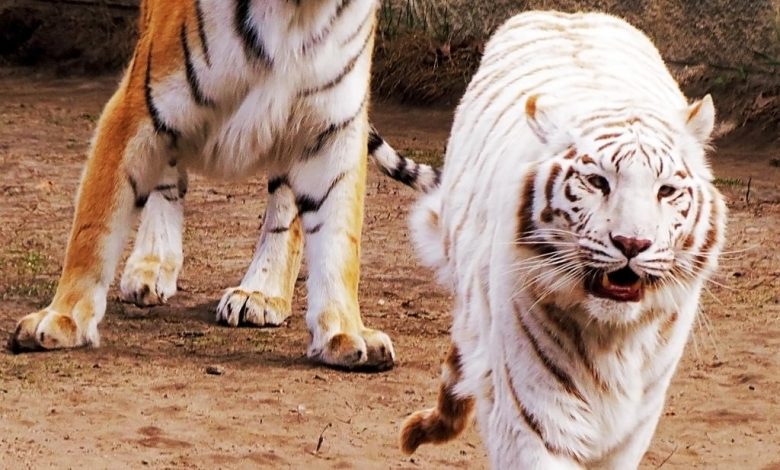To fully appreciate the comparison between Bengal tiger and Siberian tiger, it’s essential to understand their distinct characteristics.
Both species are solitary and dominant predators, representing the largest members of the cat family. Originating from Asia, Bengal tigers, also known as Royal Bengal Tigers, inhabit regions like India, Indonesia, Thailand, Bhutan, and Vietnam.
They thrive in temperate to tropical climates, often in wet mangrove forests, deciduous woodlands, and grasslands.
On the other hand, Siberian tigers, or Amur tigers, are adapted to the colder climates of East Russia, Korea, and northern China, residing in birch and coniferous forests.
The Bengal tiger is known for its thinner, light-yellow fur, while the Siberian tiger boasts a thicker, pale golden coat.
Sometimes, Siberian tigers can have a rusty red hue to their fur. Both have distinctive stripes, but while Siberian tigers have black stripes, Bengal tigers can have either black or brown.
A notable difference is the belly color – Siberian tigers have white bellies, contrasting with the white belly and inner leg parts of Bengal tigers.
White Bengal tigers are known, but there are no recorded instances of white Siberian tigers.
Both subspecies are apex predators, with sophisticated hunting abilities. Despite their prowess, they often experience a high failure rate in hunts, but their persistence typically yields success.
Siberian tigers’ diets include elk, deer, hares, rabbits, and occasionally bears. Bengal tigers predominantly feed on wild pigs, water buffalo, sambar, gaur, and other large ungulates.
Territorial behavior is a prominent trait in these tigers. Siberian tigers tend to have larger territories, spanning 2500 to 4000 square miles, compared to Bengal tigers whose territories usually cover 80 – 90 square miles.
The size of their territories can vary based on the availability of food and water sources.
Sumatran Tiger: Lifecycle, Threats, Diet and Hunting Habits
Bengal Tiger vs Siberian Tiger: A Comparative Analysis
|
SIBERIAN TIGER |
BENGAL TIGER |
| Length |
250 to 396 cm (males) / 167 to 182 cm (females) |
270 to 310 cm (males) / 240 to 265 cm (females) |
| Weight |
475 to 660 lbs (males) / 303 lbs (females) |
397 to 569 lb (males) / 220 to 350 lb (females) |
| Coat Color |
Pale dull brown in winter |
Bright yellow to orange |
| Greatest Skull Length |
406 mm |
376 mm |
| Distribution |
Russian Far East |
Indian Subcontinent |
| Primary Diet |
Sika deer, amur moose |
Chital, sambar, nilgai |
| Newborn cubs’ weight |
1.2 kg |
1.6 kg |
| Threats |
Poaching, human hunting |
Poaching, habitat loss |
| Maximum lifespan |
18 years (wild) |
15 years (wild) |
| 25 years (captivity) |
25 years (captivity) |
| Total population |
Fewer than 500 |
More the 3500 |
Siberian Tigers: Majestic Predators of East Asia
Siberian tigers, the largest subspecies of tigers, reign as apex predators in the dense forests of East Asia.
Their remarkable adaptations to the frigid climate, including a thick fur coat that ranges from pale orange to white, make them well-suited to their environment.
These tigers can reach the size of a grand piano, measuring up to 11 feet long and weighing between 700 to 800 pounds.
Their habitat, once sprawling across Russia, northeastern China, and Korea, has now been largely confined to the Sikhote-Alin mountain region in Russia, with some presence in North Korea and China.
Their diet primarily consists of large ungulates, but they are known to hunt various animals, including rabbits, salmon, and even bears.
The Siberian tiger faces significant threats from poaching and habitat loss, primarily for their fur and supposed medicinal properties.
Despite low population densities in human areas, human activities like logging and farming have greatly reduced their numbers.
Notable records and facts about Siberian Tigers:
- Guinness World Records recognize them as the “Largest feline carnivore” and “Largest wild cat.”
- Exceptional wild specimens have reportedly reached extraordinary sizes, with some historical accounts mentioning individuals weighing up to 846 pounds.
- In captivity, the record holder is the Jaipur Tiger, which reached a weight of 1025 pounds.
- Newborn cubs weigh about 1.2 kg.
- Their maximum lifespan is 15-18 years in the wild and up to 25 years in captivity.
- They face competition from brown bears, black bears, and wolves.
Tiger vs Lion Sizes: The ‘Big Cat Rivalry’
Bengal Tigers: The Second Largest Tiger Species
Bengal tigers, native to the Indian subcontinent, are among the most magnificent and largest felines on Earth.
While they are the second largest tiger species after the Siberian tiger, a Bengal tiger holds the record for the largest tiger ever documented. They are predominantly found in Bangladesh, Bhutan, India, and Nepal.
These tigers can reach lengths of up to 10 feet, including their tails, and males typically weigh between 397 and 569 pounds. Females are smaller, averaging between 220 and 350 pounds.
Bengal tigers’ diets consist of large hoofed mammals and, when necessary, other animals like leopards, wolves, and even crocodiles.
Human activities, particularly poaching and habitat destruction, pose significant threats to their survival.
Notable records and facts about Bengal Tigers:
- The Guinness World Records lists a Bengal tigress known as the Champawat Tiger for the most fatalities caused by a tiger.
- An exceptional wild specimen, now displayed at the Smithsonian Institution, measured over 10 feet long and weighed approximately 857pounds. However, this tiger had recently fed, which could have affected its weight.
- Bengal tiger cubs weigh about 1.6 kg at birth.
- Their maximum lifespan ranges from 15-18 years in the wild to up to 25 years in captivity.
- Bengal tigers face competition from various species, including the mugger crocodile and the dhole.
- The breeding season is typically in October and November, but they can mate year-round. Bengal tigers are known for their aggressive nature, contrasting the less aggressive Siberian tiger.
In conclusion, both the Siberian and Bengal tigers are majestic creatures, each with unique characteristics and challenges. Conservation efforts are crucial to ensure their survival against the backdrop of human threats like poaching and habitat loss.






